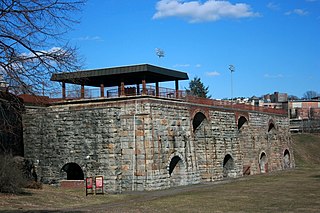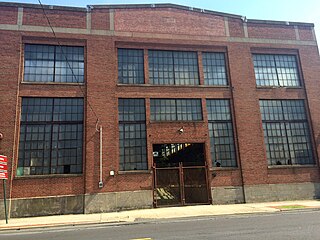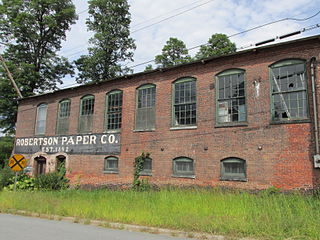
The Highland Park Ford Plant is a historic former Ford Motor Company factory located at 91 Manchester Street in Highland Park, Michigan. It was Ford's third factory, it was the second American Model T production facility and it was the first factory in history to assemble automobiles on a moving assembly line. Highland Park became a National Historic Landmark in 1978.

The Ford Piquette Avenue Plant is a former factory located within the Milwaukee Junction area of Detroit, Michigan, in the United States. Built in 1904, it was the second center of automobile production for the Ford Motor Company, after the Ford Mack Avenue Plant. At the Piquette Avenue Plant, the company created and first produced the Ford Model T, the car credited with initiating the mass use of automobiles in the United States. Prior to the Model T, several other car models were assembled at the factory. Early experiments using a moving assembly line to make cars were also conducted there. It was also the first factory where more than 100 cars were assembled in one day. While it was headquartered at the Piquette Avenue Plant, Ford Motor Company became the biggest U.S.-based automaker, and it would remain so until the mid-1920s. The factory was used by the company until 1910, when its car production activity was relocated to the new, larger Highland Park Ford Plant.

The Ford River Rouge complex is a Ford Motor Company automobile factory complex located in Dearborn, Michigan, along the River Rouge, upstream from its confluence with the Detroit River at Zug Island. Construction began in 1917, and when it was completed in 1928, it was the largest integrated factory in the world, surpassing Buick City, built in 1904.

The Peters Cartridge Company was a company located along the Little Miami River in Kings Mills, Ohio, which specialized in gunpowder and ammunition production. Founded in 1887 by Gershom Moore Peters, the company supplied military ammunition to various countries during both world wars. Following its demise in 1944, the site was repurposed by Columbia Records and later Seagram, before being abandoned in 1968 and falling into disrepair. Its historic buildings, built in 1916, were added to the National Register of Historic Places in 1985. A brewery and apartment complex themed to the defunct company was constructed on site in 2020, in which many structures were restored and the company's history was placed on display for guests.

The Phoenix Iron Works, located in Phoenixville, Pennsylvania, was a manufacturer of iron and related products during the 19th century and early 20th century. Phoenix Iron Company was a major producer of cannon for the Union Army during the American Civil War. The company also produced the Phoenix column, an advance in construction material. Company facilities are a core component of the Phoenixville Historic District, a National Register of Historic Places site that was in 2006 recognized as a historic landmark by ASM International.

The Cambria Iron Company of Johnstown, Pennsylvania, was a major producer of iron and steel that operated independently from 1852 to 1916. The company adopted many innovations in the steelmaking process, including those of William Kelly and Henry Bessemer.

The Scranton Iron Furnaces is an historic, American manufacturing site that preserves the rich heritage of iron making in Pennsylvania. It is located in Scranton, near the Steamtown National Historic Site.

The Lincoln Motor Company Plant was an automotive plant at Livernois, 6200 West Warren Avenue Detroit, Michigan, later known as the Detroit Edison Warren Service Center. The complex was designated a National Historic Landmark in 1978, due to its historic association with World War I Liberty engines and the Lincoln Motor Company. However, the main structures were demolished in 2003 and NHL designation was withdrawn in 2005.

The H. J. Heinz Company complex, part of which is currently known as Heinz Lofts, is a historic industrial complex in the Troy Hill neighborhood of Pittsburgh, Pennsylvania. The buildings were built by the H. J. Heinz Company from 1907 through 1958. The complex is listed on the National Register of Historic Places (NRHP) and five of the buildings are listed as a Pittsburgh History and Landmarks Foundation Historic Landmark.

The Neuweiler Brewery, also known as the Germania Brewery, is an historic brewery complex located in Allentown, Pennsylvania. Built between 1911 and 1913, the complex consists of the office building, brew house, stock house, pump house, wash house, chemistry lab building, boiler room, bottling house, garage, fermenting cellar, and smokestack with the name "Neuweiler" on it.

The Pitcairn Building, also known as the Pittsburgh Plate Glass Company Building, is an historic, American warehouse and light manufacturing loft building that is located at 1027 Arch Street at the corner of North 11th Street in the Chinatown neighborhood of Philadelphia, Pennsylvania.

The General Electric Switchgear Plant is a historic factory building located at 421 North 7th Street at Willow Street in the Callowhill neighborhood of Philadelphia, Pennsylvania. It was built in 1916, and is a seven-story, seven bay by nine bay, reinforced concrete building with brick facing. It was designed by William Steele & Company for General Electric, which manufactured electric switchboard equipment there.

The H.W. Butterworth and Sons Company Building, now known as 2424 Studios, is an historic factory building which is located in the Kensington neighborhood of Philadelphia, Pennsylvania.

Washington Avenue Historic District, or Washington Avenue Factory District, is a national historic district located in the Hawthorne and Bella Vista neighborhoods of South Philadelphia, Pennsylvania. It comprises the remaining four blocks of one of the last industrial neighborhoods in Philadelphia, and encompasses eight contributing buildings built between 1889 and 1927:
The Barber–Colman Company was a manufacturer of textile and milling machinery from its founding in 1894 until the 1980s. Howard Colman organized the company in Rockford, Illinois, with capital from W. A. Barber. Early successes with their Hand Knotter and Warp Tying Machine allowed the company to expand internationally, manufacturing goods in five states and three countries. The company moved to Loves Park, Illinois, in the 1950s, but struggled following the death of Walter Colman in 1983. Eurotherm Controls, Inc. currently holds the rights to the company name.

The Cocheco Mills comprise a historic mill complex in the heart of Dover, New Hampshire. The mills occupy a bend in the Cochecho River that has been site of cotton textile manufacturing since at least 1823, when the Dover Manufacturing Company supplanted earlier sawmills and gristmills. The present mill buildings were built between the 1880s and the early 20th century, and were listed on the National Register of Historic Places in 2014.

Former Parks-Cramer Company Complex is a historic factory complex located at Charlotte, Mecklenburg County, North Carolina. The contributing resources are the Manufacturing Building; Shipping, Receiving, and Pipe Storage building; storage building; and rail spur line and they were developed between 1919 and 1955. The Manufacturing Building is divided into six sections, and is a large one-story brick building with a flat roof and stepped parapets It features banks of large, steel-sash factory windows. The Parks-Cramer facility was one of the region's foremost manufacturers of humidifiers and air-conditioning equipment for the new cotton mills.

John A. Roebling's Sons Company, Trenton N.J., Block 3 is the northern portion of the former Roebling manufacturing complex in Trenton, New Jersey. The buildings date from 1908–1929 and the site was added to the National Register of Historic Places on August 22, 2012.

The Robertson Paper Company Complex was a historic industrial facility on Island Street in Bellows Falls, Vermont. It consisted of a collection of mostly-interconnected factory and related buildings, built between c. 1890 and c. 1960 by various paper-related companies. It was occupied and enlarged by the Robertson Paper Company between 1907 and its failure in 1987, at which time it was the longest-lived paper company in the state. The complex was listed on the National Register of Historic Places in 1990. It was demolished in 2018-19 as a Brownfields Economic Revitalization Alliance (BERA) project, with federal, state, and local funding.
The William Steele & Sons Company was an architectural firm that was located in Philadelphia, Pennsylvania.























